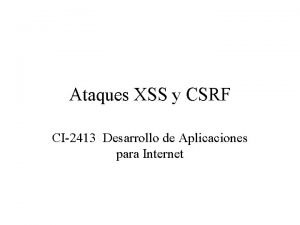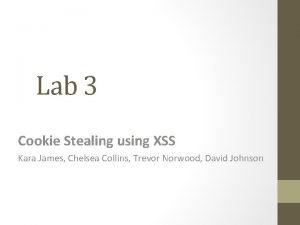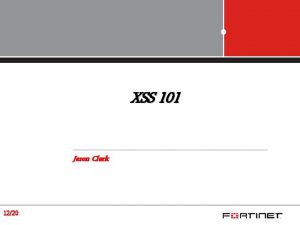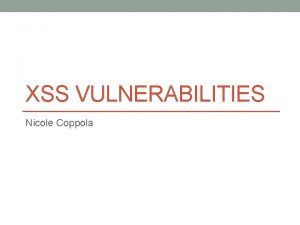CrossSite Scripting Attack XSS Outline The CrossSite Scripting






































- Slides: 38

Cross-Site Scripting Attack (XSS)

Outline ● ● ● ● The Cross-Site Scripting attack Reflected XSS Persistent XSS Damage done by XSS attacks to befriend with others XSS attacks to change other people’s profiles Self-propagation Countermeasures

The Cross-Site Scripting Attack ● In XSS, an attacker injects his/her malicious code to the victim’s browser via the target website. ● Basically, code can do whatever the user can do inside the session. ● When code comes from a website, it is considered as trusted with respect to the website, so it can access and change the content on the pages, read cookies belonging to the website and sending out requests on behalf of the user.

Types of XSS Attacks ● Non-persistent (Reflected) XSS Attack ● Persistent (Stored) XSS Attack

Non-persistent (Reflected) XSS Attack If a website with a reflective behavior takes user inputs, then : ● Attackers can put Java. Script code in the input, so when the input is reflected back, the Java. Script code will be injected into the web page from the website.

Non-persistent (Reflected) XSS Attack ● Assume a vulnerable service on website : http: //www. example. com/search? input=word, where word is provided by the users. ● Now the attacker sends the following URL to the victim and tricks him to click the link: http: //www. example. com/search? input=<script>alert(“attack”); </script> ● Once the victim clicks on this link, an HTTP GET request will be sent to the www. example. com web server, which returns a page containing the search result, with the original input in the page. The input here is a Java. Script code which runs and gives a pop-up message on the victim’s browser.

Persistent (Stored) XSS Attack ● Attackers directly send their data to a target website/server which stores the data in a persistent storage. ● If the website later sends the stored data to other users, it creates a channel between the users and the attackers. Example : User profile in a social network is a channel as it is set by one user and viewed by another.

Persistent (Stored) XSS Attack ● These channels are supposed to be data channels. ● But data provided by users can contain HTML markups and Java. Script code. ● If the input is not sanitized properly by the website, it is sent to other users’ browsers through the channel and gets executed by the browsers. ● Browsers consider it like any other code coming from the website. Therefore, the code is given the same privileges as that from the website.

Damage Caused by XSS Web defacing: Java. Script code can use DOM APIs to access the DOM nodes inside the hosting page. Therefore, the injected Java. Script code can make arbitrary changes to the page. Example: Java. Script code can change a news article page to something fake or change some pictures on the page. Spoofing requests: The injected Java. Script code can send HTTP requests to the server on behalf of the user. (Discussed in later slides) Stealing information: The injected Java. Script code can also steal victim’s private data including the session cookies, personal data displayed on the web page, data stored locally by the web application.

Environment Setup ● Elgg: open-source web application for social networking with disabled countermeasures for XSS. ● Elgg website : http: //www. xsslabelgg. com ● The website is hosted on localhost via Apache’s Virtual Hosting

Attack Surfaces for XSS attack ● To launch an attack, we need to find places where we can inject Java. Script code. ● These input fields are potential attack surfaces wherein attackers can put Java. Script code. ● If the web application doesn’t remove the code, the code can be triggered on the browser and cause damage. ● In our task, we will insert our code in the “Brief Description” field, so that when Alice views Samy’s profile, the code gets executed with a simple message.

XSS Attacks to Befriend with Others Goal: Add Samy to other people’s friend list without their consent. Investigation taken by attacker Samy: ● Samy clicks “add-friend” button from Charlie’s account (discussed in CSRF) to add himself to Charlie’s friend list. ● Using Firefox’s Live. HTTPHeader extension, he captures the add-friend request.

XSS Attacks to Befriend with Others Line ①: URL of Elgg’s add-friend request. User. ID of the user to be added to the friend list is used. Here, Samy’s User. ID (GUID) is 47. Line ③: Session cookie which is unique for each user. It is automatically sent by browsers. Here, if the attacker wants to access the cookies, it will be allowed as the Java. Script code is from Elgg website and not a thirdparty page like in CSRF. Line ②: Elgg’s countermeasure against CSRF attacks (this is now enabled).

XSS Attacks to Befriend with Others The main challenge is to find the values of CSRF countermeasures parameters : _elgg_ts and _elgg_token. Line ① and ②: The secret values are assigned to two Java. Script variables, which make our attack easier as we can load the values from these variables. Our Java. Script code is injected inside the page, so it can access the Java. Script variables inside the page.

Construct an Add-friend Request Line ① and ②: Get timestamp and secret token from the Java. Script variables. Line ③ and ④: Construct the URL with the data attached. The rest of the code is to create a GET request using Ajax.

Inject the Code Into a Profile ● Samy puts the script in the “About Me” section of his profile. ● After that, let’s login as “Alice” and visit Samy’s profile. ● Java. Script code will be run and not displayed to Alice. ● The code sends an addfriend request to the server. ● If we check Alice’s friends list, Samy is added.

XSS Attacks to Change Other People’s Profiles Goal: Putting a statement “SAMY is MY HERO” in other people’s profile without their consent. Investigation taken by attacker Samy : ● Samy captured an edit-profile request using Live. HTTPHeader.

Captured HTTP Request Line ①: URL of the edit-profile service. Line ②: Session cookie (unique for each user). It is automatically set by browsers. Line ③: CSRF countermeasures, which are now enabled.

Captured HTTP Request (continued) • Line ④: Description field with our text “Samy is my hero” • Line ⑤: Access level of each field: 2 means the field is viewable to everyone. • Line ⑥: User ID (GUID) of the victim. This can be obtained by visiting victim’s profile page source. In XSS, as this value can be obtained from the page. As we don’t want to limit our attack to one victim, we can just add the GUID from Java. Script variable called elgg. session. user. guid.

Construct the Malicious Ajax Request

Construct the Malicious Ajax Request To ensure that it does not modify Samy’s own profile or it will overwrite the malicious content in Samy’s profile.

Inject the into Attacker’s Profile ● Samy can place the malicious code into his profile and then wait for others to visit his profile page. ● Login to Alice’s account and view Samy’s profile. As soon as Samy’s profile is loaded, malicious code will get executed. ● On checking Alice profile, we can see that “SAMY IS MY HERO” is added to the “About me” field of her profile.

Self-Propagation XSS Worm Using Samy’s worm, not only will the visitors of Samy’s profile be modified, their profiles can also be made to carry a copy of Samy’s Java. Script code. So, when an infected profile was viewed by others, the code can further spread. Challenges: How can Java. Script code produce a copy of itself? Two typical approaches: ● DOM approach: Java. Script code can get a copy of itself directly from DOM via DOM APIs ● Link approach: Java. Script code can be included in a web page via a link using the src attribute of the script tag.

Self -Propagation XSS Worm

Self-Propagation XSS Worm Document Object Model (DOM) Approach : ● ● DOM organizes the contents of the page into a tree of objects (DOM nodes). Using DOM APIs, we can access each node on the tree. If a page contains Java. Script code, it will be stored as an object in the tree. So, if we know the DOM node that contains the code, we can use DOM APIs to get the code from the node. ● Every Java. Script node can be given a name and then use the document. get. Element. By. ID() API to find the node.

Self-Propagation XSS Worm ● Use “document. get. Element. By. Id(“worm”) to get the reference of the node ● inner. HTML gives the inside part of the node, not including the script tag. ● So, in our attack code, we can put the message in the description field along with a copy of the entire code.

Self-Propagation XSS Worm Line ① and ②: Construct a copy of the worm code, including the script tags. Line ②: We split the string into two parts and use “+” to concatenate them together. If we directly put the entire string, Firefox’s HTML parser will consider the string as a closing tag of the script block and the rest of the code will be ignored.

Self-Propagation XSS Worm Line ③: In HTTP POST requests, data is sent with Content-Type as “application/x-www-form-urlencoded”. We use encode. URIComponent() function to encode the string. Line ④: Access level of each field: 2 means public. After Samy places this self-propagating code in his profile, when Alice visits Samy’s profile, the worm gets executed and modifies Alice’s profile, inside which, a copy of the worm code is also placed. So, any user visiting Alice’s profile will too get infected in the same way.

Self-Propagation XSS Worm: The Link Approach ● The Java. Script code xssworm. js will be fetched from the URL. ● Hence, we do not need to include all the worm code in the profile. ● Inside the code, we need to achieve damage and self-propagation.

Countermeasures: the Filter Approach ● Removes code from user inputs. ● It is difficult to implement as there are many ways to embed code other than <script> tag. ● Use of open-source libraries that can filter out Java. Script code. ● Example : jsoup

Countermeasures: The Encoding Approach ● Replaces HTML markups with alternate representations. ● If data containing Java. Script code is encoded before being sent to the browsers, the embedded Java. Script code will be displayed by browsers, not executed by them. ● Converts <script> alert(‘XSS’) </script> to < script> alert(‘XSS’)

Countermeasures: Elgg’s Approach PHP module HTMLawed: Highly customizable PHP script to sanitize HTML against XSS attacks. PHP function htmlspecialchars: Encode data provided by users, s. t. , Java. Script code in user’s inputs will be interpreted by browsers only as strings and not as code.

Defeating XSS using Content Security Policy ● Fundamental Problem: mixing data and code (code is inlined) ● Solution: Force data and code to be separated: (1) Don’t allow the inline approach. (2) Only allow the link approach.

CSP Example ● Policy based on the origin of the code Code from self, example. com, and google will be allowed.

How to Securely Allow Inlined Code ● Using nonce Allowed Not allowed ● Using hash of the code

Setting CSP Rules

Discussion Questions Question 1: What are the main differences of CSRF and XSS attacks? They both have “cross site” in their names. Question 2: Can we use the countermeasures against CSRF attacks to defend against XSS attacks, including the secret token and same-site cookie approaches?

Summary ● Two types of XSS attacks ● How to launch XSS attacks ● Create a self-propagating XSS worm ● Countermeasures against XSS attacks
 Active attack and passive attack
Active attack and passive attack Passive attack and active attack
Passive attack and active attack Xssxss
Xssxss Xss filter bypass
Xss filter bypass Flash xss
Flash xss Java xss filter
Java xss filter Img srcx onerroralert1
Img srcx onerroralert1 Reflected xss
Reflected xss Xxss stored xss download
Xxss stored xss download Xss vs csrf
Xss vs csrf Advanced xss
Advanced xss Waf bypass techniques
Waf bypass techniques Webgoat installation windows 10
Webgoat installation windows 10 Reflected xss
Reflected xss Xss me firefox
Xss me firefox Sqlmap xss
Sqlmap xss Xss steal cookie
Xss steal cookie Xss methodology
Xss methodology Propfind 메소드 취약점
Propfind 메소드 취약점 Examples of quote sandwiches
Examples of quote sandwiches Các loại đột biến cấu trúc nhiễm sắc thể
Các loại đột biến cấu trúc nhiễm sắc thể Nguyên nhân của sự mỏi cơ sinh 8
Nguyên nhân của sự mỏi cơ sinh 8 độ dài liên kết
độ dài liên kết Chó sói
Chó sói Thiếu nhi thế giới liên hoan
Thiếu nhi thế giới liên hoan điện thế nghỉ
điện thế nghỉ Một số thể thơ truyền thống
Một số thể thơ truyền thống Trời xanh đây là của chúng ta thể thơ
Trời xanh đây là của chúng ta thể thơ Thế nào là hệ số cao nhất
Thế nào là hệ số cao nhất Frameset trong html5
Frameset trong html5 Hệ hô hấp
Hệ hô hấp So nguyen to
So nguyen to đặc điểm cơ thể của người tối cổ
đặc điểm cơ thể của người tối cổ Phối cảnh
Phối cảnh Các châu lục và đại dương trên thế giới
Các châu lục và đại dương trên thế giới Tư thế worm breton
Tư thế worm breton ưu thế lai là gì
ưu thế lai là gì Tư thế ngồi viết
Tư thế ngồi viết Cái miệng xinh xinh thế chỉ nói điều hay thôi
Cái miệng xinh xinh thế chỉ nói điều hay thôi

























































